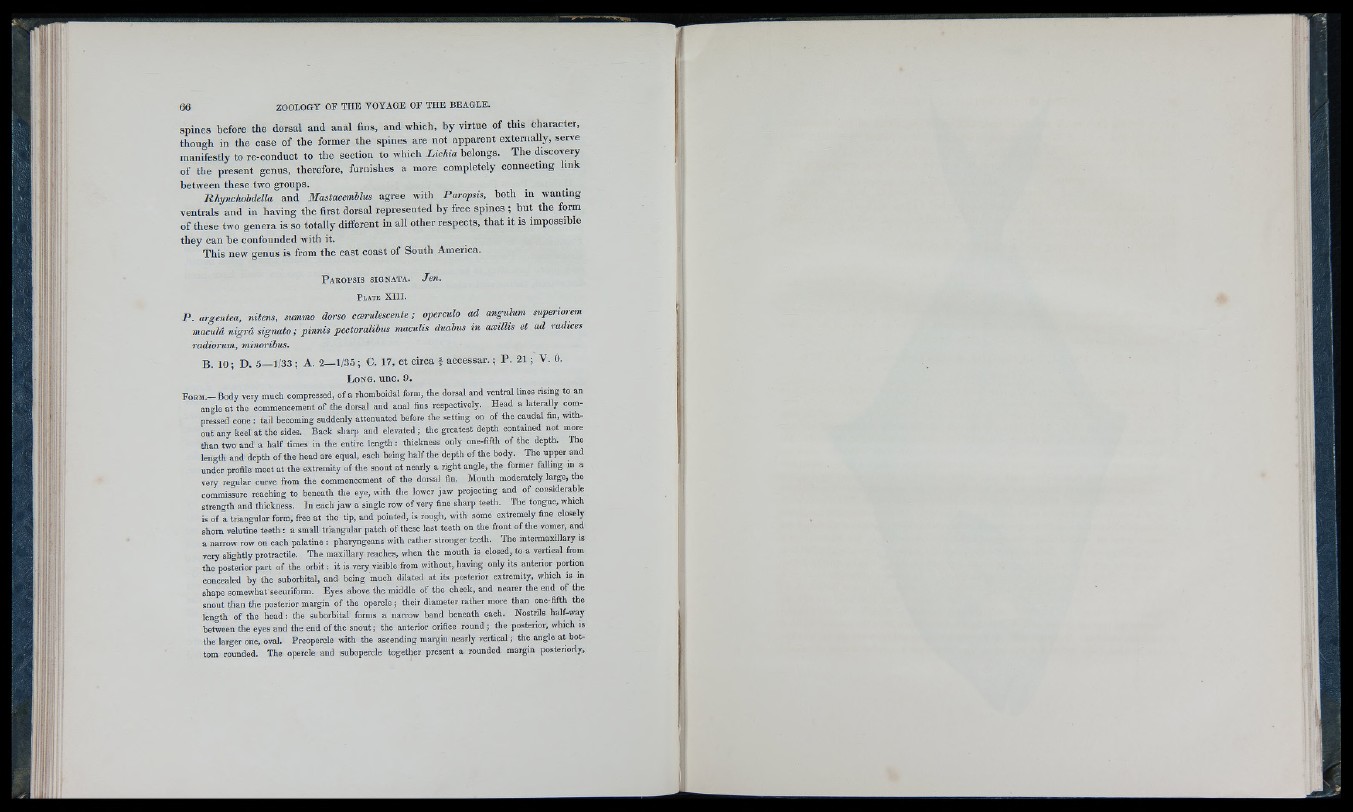
il
spines before the dorsal and anal fins, and which, by virtue of this character,
though in the case of the former the spines are not apparent externally, serve
manifestly to re-conduct to the section to which Lichia belongs. The discovery
of the present genus, therefore, furnishes a more completely connecting link
between these two groups.
Rlnjmhobddla and MastacemUus agree with Paropsis, both in wanting
ventrals and in having the first dorsal represented by free spines ; hut the form
of these two genera is so totally different in all other respects, that it is impossible
they can be confounded with it.
This new genus is from the east coast of South America.
P a r o p s is s ig n a t a . Jen.
P l a t e X III.
P . argeniea, nitens, summo dorso carulescente; opercido ad angulum mperiorem
macidd nigra signato; pinnis pectoralibus maculis duabus in axillis et ad radices
radiorum, mitioribus.
B. 10; D. 5—1/33; A. 2—1,35 ; C. 17, et circa A accessar.; P . 21; V. 0.
L o n g . u n c . 9 .
F o r m . - B ody very much compressed, of a rhomboidal form, the dorsal and ventral lines rising to an
angle at the commencement of the dorsal and anal fins respectively. Head a laterally compressed
cone : tail becoming suddenly attenuated before the setting on of the caudal fln, without
any keel a t the sides. B ack sharp and elevated; the greatest depth contained not more
than two and a half times in the entire length : thickness only one-fifth of the depth. The
length and depth of the head are equal, each being h alf the depth of the body. The upper and
under profile meet a t the extremity of the snout a t nearly a right angle, the former falling in a
very regular curve from the commencement of the dorsal fin. M outh moderately large, the
commissure reaching to beneath the eye, with the lower jaw projecting and of considerable
strength and thickness. In each jaw a single row of very fine sharp teeth. The tongue, which
is of a triangular form, free at the tip, and pointed, is rough, with some extremely fine closely
shorn velutine te e ü i: a small triangular patch of these last teeth on the front of the vomer, and
a narrow row on each palatine : pharyngeans with rather stronger teeth. The intermaxillary is
very slightly protractile. The maxillary reaches, when the mouth is closed, to a vertical from
the posterior part of the o rb it: it is very visible from without, having only its anterior portion
and beinff much dilated at its posterior extremity,concealed by the suborbital, being < which is in
shape somewhat securiform. Eyes above the middle of the cheek, and nearer the end of the
snout than the posterior margin of the opercle; their diameter rather more than one-fifth the
length of the h e a d : the suborbital forms a narrow band beneath each. Nostrils half-way
between the eyes and the end of the snout; the anterior orifice rou nd ; the posterior, which is
the larger one, oval. Preopercle with the ascending margin nearly vertical; the angle at bottom
rounded. The opercle and subopercle together present a rounded m ai^in posteriorly.